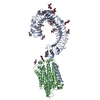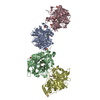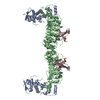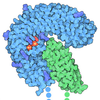+ Open data
Open data
- Basic information
Basic information
| Entry | Database: PDB / ID: 7c77 | ||||||
|---|---|---|---|---|---|---|---|
| Title | Cryo-EM structure of mouse TLR3 in complex with UNC93B1 | ||||||
 Components Components |
| ||||||
 Keywords Keywords | IMMUNE SYSTEM / Toll-like receptors / UNC93B1 / MFS | ||||||
| Function / homology |  Function and homology information Function and homology informationTrafficking and processing of endosomal TLR / type III interferon production / positive regulation of type III interferon production / toll-like receptor 7 signaling pathway / T cell antigen processing and presentation / regulation of dendritic cell cytokine production / Toll-like receptor binding / inflammatory response to wounding / toll-like receptor 3 signaling pathway / toll-like receptor 9 signaling pathway ...Trafficking and processing of endosomal TLR / type III interferon production / positive regulation of type III interferon production / toll-like receptor 7 signaling pathway / T cell antigen processing and presentation / regulation of dendritic cell cytokine production / Toll-like receptor binding / inflammatory response to wounding / toll-like receptor 3 signaling pathway / toll-like receptor 9 signaling pathway / necroptotic signaling pathway / early phagosome / positive regulation of cytokine production involved in inflammatory response / positive regulation of macrophage cytokine production / toll-like receptor signaling pathway / pattern recognition receptor activity / cellular response to exogenous dsRNA / antigen processing and presentation / response to exogenous dsRNA / ubiquitin-like protein ligase binding / positive regulation of interferon-alpha production / positive regulation of type I interferon production / cellular response to interferon-beta / positive regulation of chemokine production / JNK cascade / extrinsic apoptotic signaling pathway / positive regulation of interleukin-12 production / positive regulation of interferon-beta production / positive regulation of interleukin-8 production / positive regulation of JNK cascade / intracellular protein transport / microglial cell activation / cellular response to mechanical stimulus / positive regulation of non-canonical NF-kappaB signal transduction / defense response / antigen processing and presentation of exogenous peptide antigen via MHC class II / cellular response to virus / cellular response to type II interferon / positive regulation of interleukin-6 production / response to virus / male gonad development / cellular response to xenobiotic stimulus / positive regulation of type II interferon production / cell morphogenesis / positive regulation of angiogenesis / positive regulation of tumor necrosis factor production / transmembrane signaling receptor activity / MAPK cascade / double-stranded RNA binding / defense response to virus / early endosome / lysosome / positive regulation of canonical NF-kappaB signal transduction / endosome / endosome membrane / positive regulation of apoptotic process / innate immune response / endoplasmic reticulum membrane / cell surface / endoplasmic reticulum / positive regulation of transcription by RNA polymerase II / identical protein binding / plasma membrane Similarity search - Function | ||||||
| Biological species |  | ||||||
| Method | ELECTRON MICROSCOPY / single particle reconstruction / cryo EM / Resolution: 3.3 Å | ||||||
 Authors Authors | Ohto, U. / Ishida, H. / Shimizu, T. | ||||||
 Citation Citation |  Journal: Nat Struct Mol Biol / Year: 2021 Journal: Nat Struct Mol Biol / Year: 2021Title: Cryo-EM structures of Toll-like receptors in complex with UNC93B1. Authors: Hanako Ishida / Jinta Asami / Zhikuan Zhang / Tomohiro Nishizawa / Hideki Shigematsu / Umeharu Ohto / Toshiyuki Shimizu /  Abstract: Nucleic acid-sensing Toll-like receptors (TLRs) play a pivotal role in innate immunity by recognizing foreign DNA and RNA. Compartmentalization of these TLRs in the endosome limits their activation ...Nucleic acid-sensing Toll-like receptors (TLRs) play a pivotal role in innate immunity by recognizing foreign DNA and RNA. Compartmentalization of these TLRs in the endosome limits their activation by self-derived nucleic acids and reduces the possibility of autoimmune reactions. Although chaperone Unc-93 homolog B1, TLR signaling regulator (UNC93B1) is indispensable for the trafficking of TLRs from the endoplasmic reticulum to the endosome, mechanisms of UNC93B1-mediated TLR regulation remain largely unknown. Here, we report two cryo-EM structures of human and mouse TLR3-UNC93B1 complexes and a human TLR7-UNC93B1 complex. UNC93B1 exhibits structural similarity to the major facilitator superfamily transporters. Both TLRs interact with the UNC93B1 amino-terminal six-helix bundle through their transmembrane and luminal juxtamembrane regions, but the complexes of TLR3 and TLR7 with UNC93B1 differ in their oligomerization state. The structural information provided here should aid in designing compounds to combat autoimmune diseases. | ||||||
| History |
|
- Structure visualization
Structure visualization
| Movie |
 Movie viewer Movie viewer |
|---|---|
| Structure viewer | Molecule:  Molmil Molmil Jmol/JSmol Jmol/JSmol |
- Downloads & links
Downloads & links
- Download
Download
| PDBx/mmCIF format |  7c77.cif.gz 7c77.cif.gz | 230.5 KB | Display |  PDBx/mmCIF format PDBx/mmCIF format |
|---|---|---|---|---|
| PDB format |  pdb7c77.ent.gz pdb7c77.ent.gz | 180.8 KB | Display |  PDB format PDB format |
| PDBx/mmJSON format |  7c77.json.gz 7c77.json.gz | Tree view |  PDBx/mmJSON format PDBx/mmJSON format | |
| Others |  Other downloads Other downloads |
-Validation report
| Summary document |  7c77_validation.pdf.gz 7c77_validation.pdf.gz | 1.1 MB | Display |  wwPDB validaton report wwPDB validaton report |
|---|---|---|---|---|
| Full document |  7c77_full_validation.pdf.gz 7c77_full_validation.pdf.gz | 1.1 MB | Display | |
| Data in XML |  7c77_validation.xml.gz 7c77_validation.xml.gz | 37.4 KB | Display | |
| Data in CIF |  7c77_validation.cif.gz 7c77_validation.cif.gz | 56.1 KB | Display | |
| Arichive directory |  https://data.pdbj.org/pub/pdb/validation_reports/c7/7c77 https://data.pdbj.org/pub/pdb/validation_reports/c7/7c77 ftp://data.pdbj.org/pub/pdb/validation_reports/c7/7c77 ftp://data.pdbj.org/pub/pdb/validation_reports/c7/7c77 | HTTPS FTP |
-Related structure data
| Related structure data |  30294MC  7c76C  7cynC M: map data used to model this data C: citing same article ( |
|---|---|
| Similar structure data |
- Links
Links
- Assembly
Assembly
| Deposited unit | 
|
|---|---|
| 1 |
|
- Components
Components
| #1: Protein | Mass: 103785.797 Da / Num. of mol.: 1 Source method: isolated from a genetically manipulated source Source: (gene. exp.)   Homo sapiens (human) / References: UniProt: Q99MB1 Homo sapiens (human) / References: UniProt: Q99MB1 | ||||||
|---|---|---|---|---|---|---|---|
| #2: Protein | Mass: 67039.250 Da / Num. of mol.: 1 Source method: isolated from a genetically manipulated source Source: (gene. exp.)   Homo sapiens (human) / References: UniProt: Q8VCW4 Homo sapiens (human) / References: UniProt: Q8VCW4 | ||||||
| #3: Polysaccharide | beta-D-mannopyranose-(1-4)-2-acetamido-2-deoxy-beta-D-glucopyranose-(1-4)-2-acetamido-2-deoxy-beta- ...beta-D-mannopyranose-(1-4)-2-acetamido-2-deoxy-beta-D-glucopyranose-(1-4)-2-acetamido-2-deoxy-beta-D-glucopyranose Source method: isolated from a genetically manipulated source | ||||||
| #4: Polysaccharide | 2-acetamido-2-deoxy-beta-D-glucopyranose-(1-4)-2-acetamido-2-deoxy-beta-D-glucopyranose Source method: isolated from a genetically manipulated source #5: Sugar | ChemComp-NAG / Has ligand of interest | N | Has protein modification | Y | |
-Experimental details
-Experiment
| Experiment | Method: ELECTRON MICROSCOPY |
|---|---|
| EM experiment | Aggregation state: PARTICLE / 3D reconstruction method: single particle reconstruction |
- Sample preparation
Sample preparation
| Component | Name: Complex of TLR3 and UNC93B1 / Type: COMPLEX / Entity ID: #1-#2 / Source: RECOMBINANT |
|---|---|
| Source (natural) | Organism:  |
| Source (recombinant) | Organism:  Homo sapiens (human) / Cell: Expi293F Homo sapiens (human) / Cell: Expi293F |
| Buffer solution | pH: 7.5 Details: 25 mM Hepes-NaOH, pH 7.5, 0.2 M NaCl, and 0.01% GDN |
| Specimen | Embedding applied: NO / Shadowing applied: NO / Staining applied: NO / Vitrification applied: YES |
| Vitrification | Cryogen name: ETHANE |
- Electron microscopy imaging
Electron microscopy imaging
| Experimental equipment |  Model: Titan Krios / Image courtesy: FEI Company |
|---|---|
| Microscopy | Model: FEI TITAN KRIOS |
| Electron gun | Electron source:  FIELD EMISSION GUN / Accelerating voltage: 300 kV / Illumination mode: OTHER FIELD EMISSION GUN / Accelerating voltage: 300 kV / Illumination mode: OTHER |
| Electron lens | Mode: BRIGHT FIELD |
| Image recording | Electron dose: 60 e/Å2 / Film or detector model: GATAN K3 (6k x 4k) |
- Processing
Processing
| CTF correction | Type: NONE |
|---|---|
| 3D reconstruction | Resolution: 3.3 Å / Resolution method: FSC 0.143 CUT-OFF / Num. of particles: 72000 / Symmetry type: POINT |
 Movie
Movie Controller
Controller











 PDBj
PDBj






